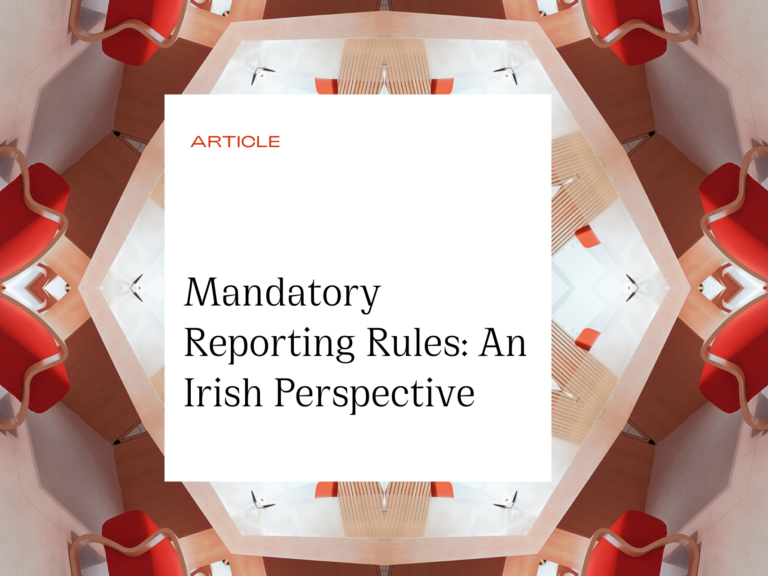
A voluntary or mandatory EU Green Bond Standard? The debate continues
This article was published The Finance Dublin Yearbook 2022. View the full issue here.
The European Commission launched its proposed EU Green Bond Standard in July 2021 but the scope and nature of the proposals have changed significantly as it works its way through the EU legislative apparatus, drawing criticism from the financial services sector write Arthur Cox’s Brendan Wallace and Aisling Kelly. They outline the progress to date of the proposals and what stakeholders can do now despite uncertainty around the nature of final standard.
On 6 July 2021, the European Commission (the “Commission”) proposed a new voluntary EU Green Bond Standard (EU GBS). In this article we explain the background to the proposal, what it could mean for existing and future issuers of environmentally sustainable bonds, and how the latest proposals from the European Parliament and European Central Bank (“ECB”) to amend the scope of the draft regulation that underpins the proposed EU GBS (the “EU GBS Regulation”‘ could result in a far more wide reaching framework than initially proposed.
European Green Deal and Sustainable Finance Strategy
The European Green Deal”, launched in December 2019, is the EU’s action plan to respond to climate change and other environmental related challenges. Recognising that the level of investment required to achieve the targets set out in the European Green Deal requires significant private financing as well as public investment, the Commission adopted the European Green Deal Investment Plan in January 2020 and the Sustainable Finance Strategy’ in July 2021 as cornerstones of its strategy to tackle climate change.
The Sustainable Finance Strategy aims to re-orient private investment towards more sustainable technologies and businesses (e.g. green activities) and includes specific actions to increase the contribution of the financial sector to sustainability. One of these actions is the proposed adoption of an EU GBS.
The EU GBS
The Commission intends the EU GBS to be a ‘gold standard for green bonds which would allow companies and public bodies to raise the large-scale financing required for climate and environmentally-friendly investments more easily, while also setting specific sustainability targets and protecting investors from greenwashing. It also intends that any issuer of green bonds, whether inside or outside of the EU, would be able to use the designation European Green Bond’ / ‘EuGB’ if certain requirements are met. This would include corporates, sovereigns, financial institutions, and issuers of covered bonds and asset-backed securities There are four key requirements under the proposed EU GBS Regulation for an issuer to be able to use the ‘European Green Bond’ / ‘EuGB’ designation:
The funds raised by the bond should be fully allocated to projects aligned with the EU Taxonomy.
There must be full transparency on how bond proceeds are allocated through detailed reporting requirements such as pre-issuance factsheets and annual post issuance allocation reports. The bond must be checked by an external reviewer to ensure that, pre-issuance, it is aligned with the EU Taxonomy and, post-issuance, its proceeds have been allocated in an EU Taxonomy-aligned manner. Specific, limited flexibility is foreseen here for sovereign issuers so that they can use state auditors or other public entities for post-issuance reviews, and so that they may be able to demonstrate EU Taxonomy-alignment at a programme level rather than at a project level.
External reviewers providing services to issuers of EU green bonds must be registered with and supervised by the European Securities Markets Authority. This is intended to ensure the quality and reliability of their services and reviews to protect investors and ensure market integrity. ESMA is keen to prioritise registrations for EU-based external reviewers first, before moving to registrations of third country external reviewers.
Alignment with EU Taxonomy
As mentioned above, a cornerstone of the EU GBS is that proceeds of a ‘European Green Bond’ / ‘EuGB’ must be used for projects aligned with the EU Taxonomy. The EU Taxonomy is a classification system established pursuant to the EU Taxonomy Regulation to distinguish between economic activities that are “environmentally sustainable” and those that are not. Although some activities are not covered by the EU Taxonomy, use of the EU Taxonomy should provide greater certainty to issuers on what activities qualify as sustainable, while investors buying the bonds will be able to verify more easily that this is the case, thereby reducing the risk of greenwashing.
Will the EU GBS be voluntary or mandatory?
As mentioned above, when initiating the legislative process for the EU GBS Regulation in 2021, the Commission proposed that it would be a voluntary standard, which could co-exist alongside existing standards, such as the International Capital Market Association (“ICMA“) Green Bond Principles. However, the proposal has been working its way through the EU legislative process and the rapporteur working on the legislation for the European Parliament published their draft report in December 2021 in which they proposed a number of significant amendments. Among these amendments is a proposal to require the Commission to determine, by December 2023, the deadline for, and practicalities of, making it mandatory to obtain the ‘European Green Bond’ / ‘EuGB’ designation for all bonds marketed as environmentally sustainable between 2025 and 2028, and to subsequently propose a revised version of the EU GBS Regulation to make the EU GBS mandatory within that time-frame. This proposal is aligned with the views of the ECB (which suggests mandatory adoption of the EU GBS within three to five years) but has attracted criticism from some market participants. ICMA in particular has suggested that a move to make the EU GBS mandatory for green or sustainable issuers would lead to “an unsustainable level of additional cost and liability for Issuers” and lead to market fragmentation as issuers would switch to other sources of finance.
What does the proposed EU GBS mean for existing and future issuers of sustainable bonds?
As the EU GBS Regulation continues to make its way through the EU legislative process, existing issuers of green and sustainable bonds do not need to take any action at this point in time. It is advisable for issuers who are looking at initiating projects to be funded by green or sustainable bonds at some point in the future to consider whether the projects in question are aligned with the EU Taxonomy, so that they would be in a position to benefit from the EU GBS when it is adopted.
Brendan Wallace and Aisling Kelly are partners in Arthur Cox’s Capital Markets team and advise clients on a range of matters relating to green and sustainable bond issuance. This has included advising the financial institutions involved in Ireland ‘s first sovereign green bond.



